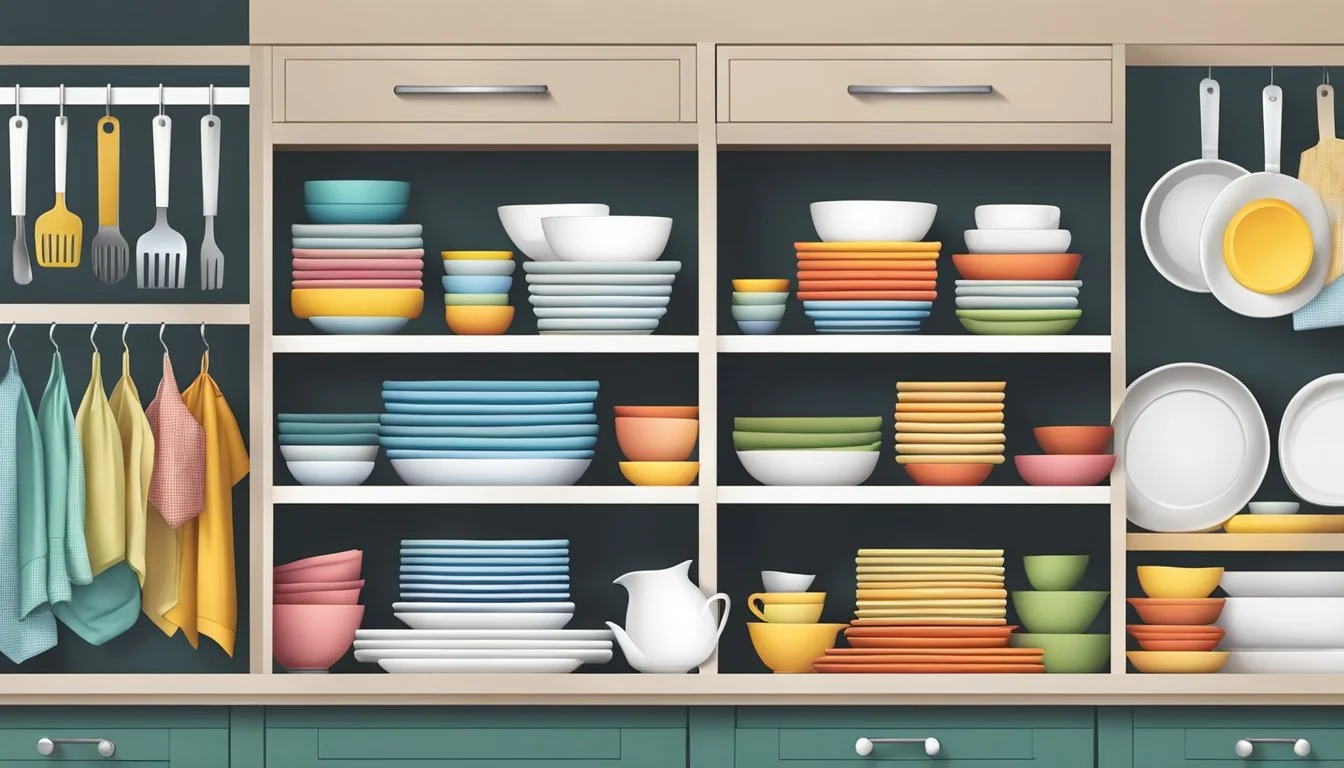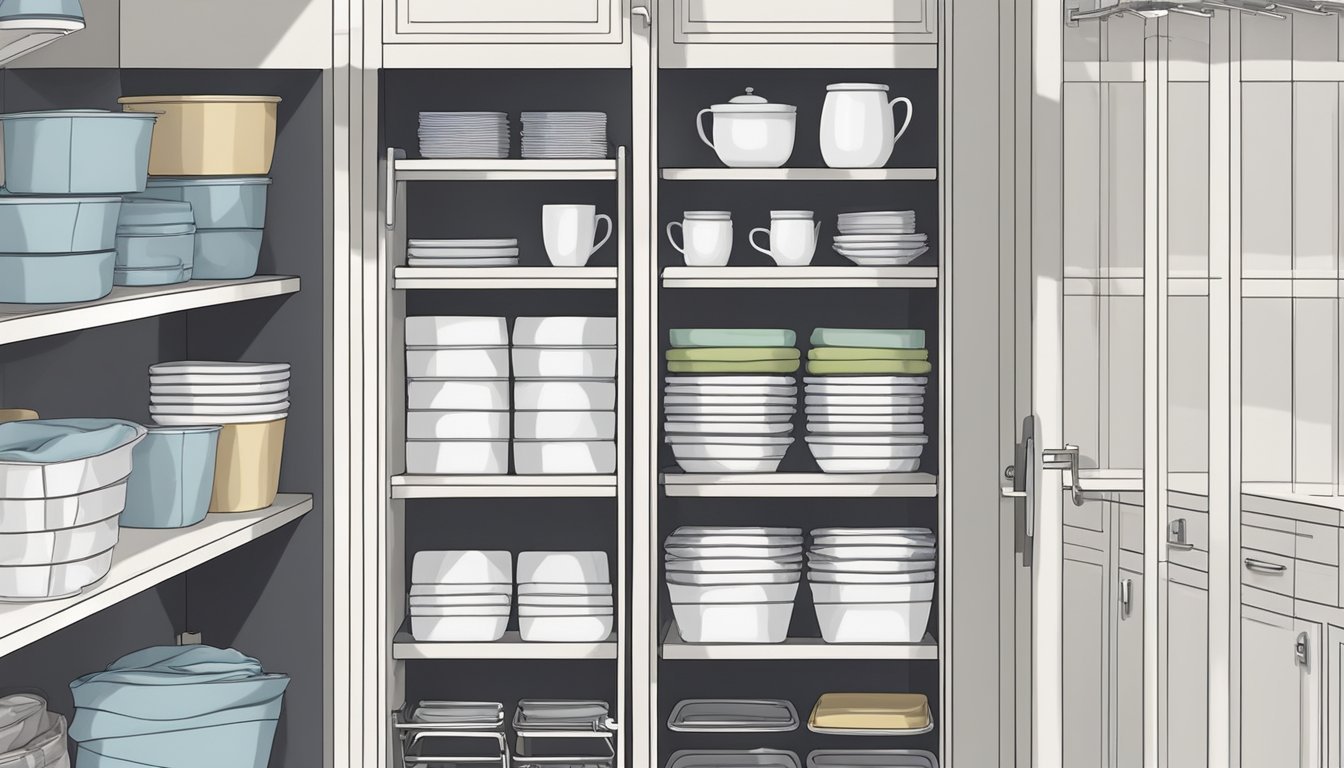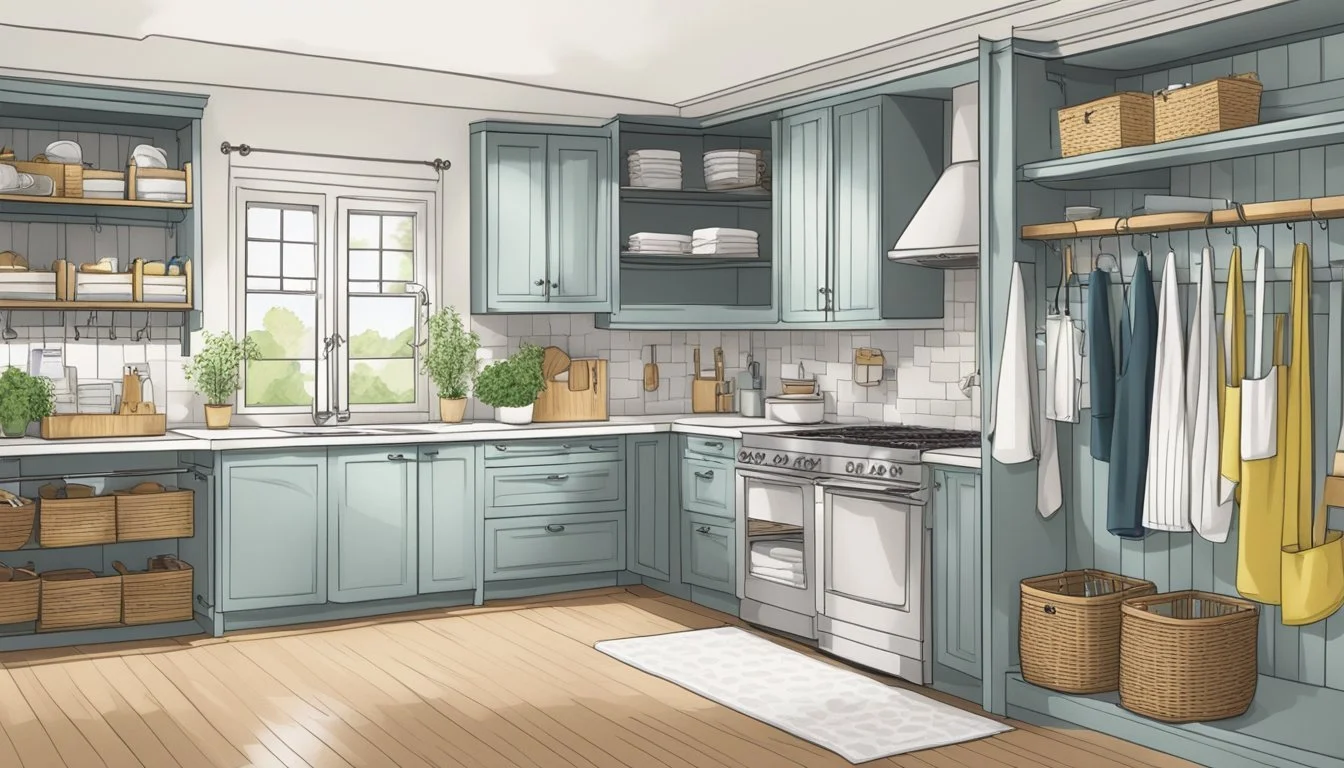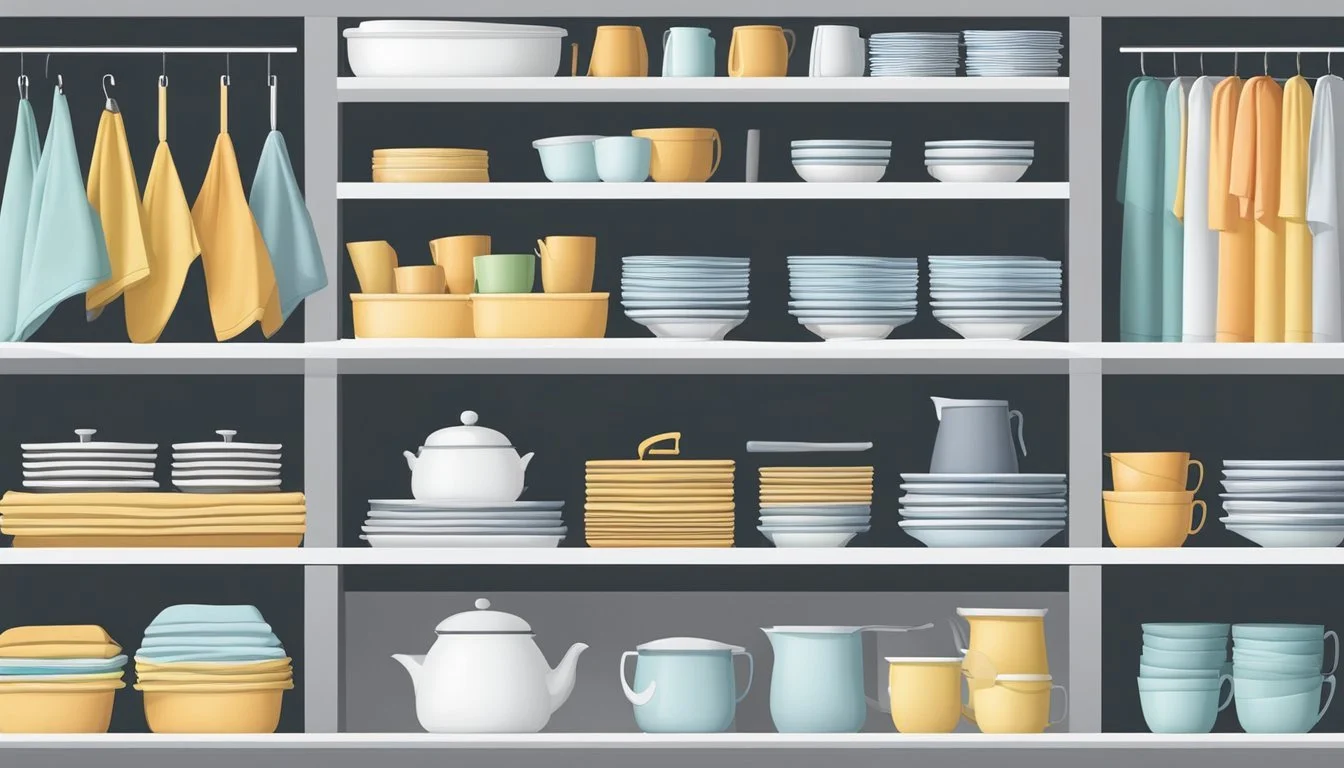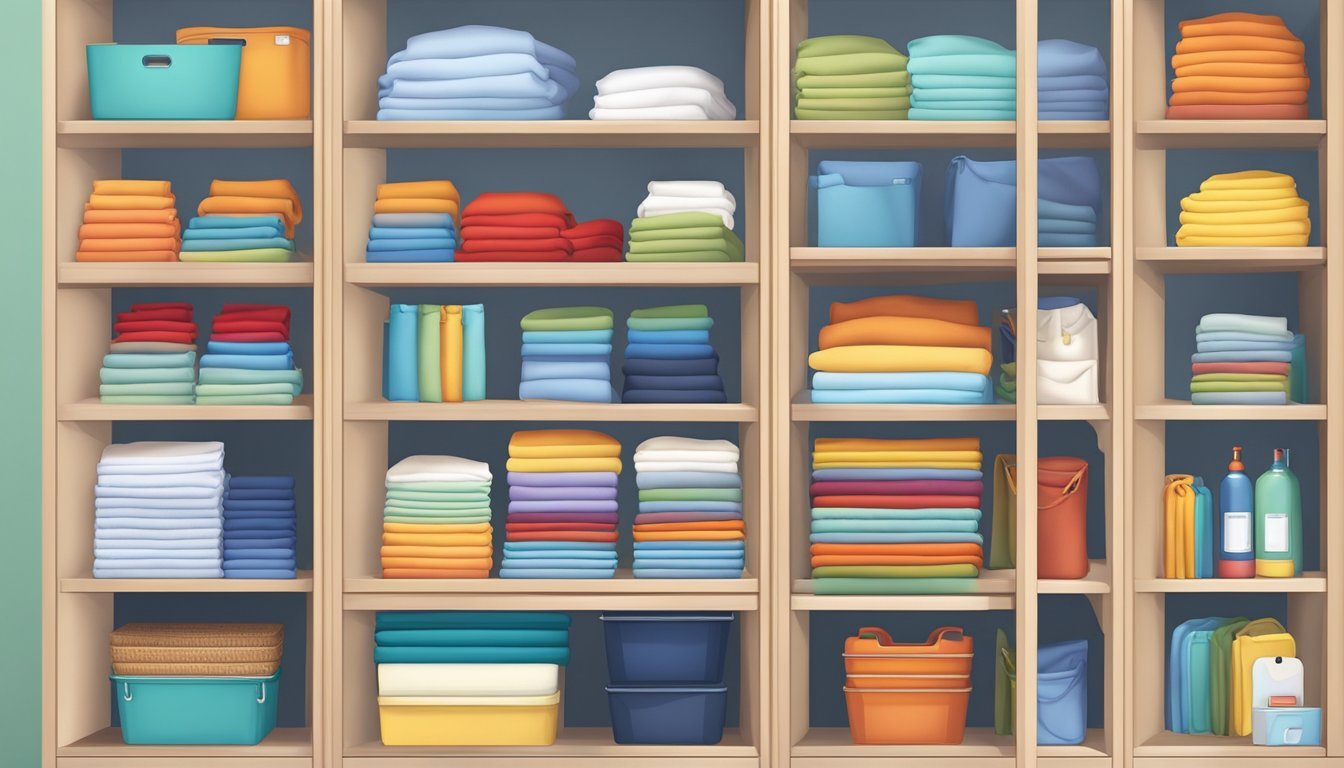10 Clever Ways to Store Your Kitchen Linens
Maximizing Space and Organization
Kitchen linens are essential for a well-functioning culinary space, serving both utilitarian and aesthetic purposes. The challenge of storing these items can be daunting, especially when space is at a premium. Optimal organization of dish towels, tablecloths, and napkins ensures that they are easily accessible while also being protected from damage and clutter.
Innovative storage solutions have materialized that transform the quintessential way kitchen linens are organized. Whether one is employing clever cabinet accessories such as shelf liners and dividers or repurposing furniture pieces like storage benches for dual function, these methods promote order and accessibility. Bearing in mind the value of maximizing underused spaces, options like over-the-door racks and internal drawer systems present inventive avenues to keep linens neatly stored.
Understanding the various materials and sizes of kitchen linens is just as crucial as selecting the right storage method. Protection from moisture, light, and pests ensures the longevity of these household fabrics. Thus, strategic organization not only contributes to a kitchen's efficiency and tidiness but also preserves the quality of the linens themselves, guaranteeing their readiness for both everyday use and special occasions.
Maximizing Cabinet Storage
When organizing kitchen linens in cabinets, strategic use of dividers, baskets, bins, and hooks transforms clutter into an orderly system. This maximizes every inch of available space and allows for quick access to items when needed.
Using Dividers and Roll-Out Baskets
Kitchen cabinet dividers effectively separate dish towels, napkins, and tablecloths, making it easy to grab what's needed without disarranging the rest. Roll-out baskets serve as drawers, providing clear visibility and accessibility, especially useful in lower cabinets where reaching in the back is often a challenge.
Optimizing Upper Cabinets with Bins and Racks
In upper cabinets, lightweight storage bins can be labeled and stacked to organize smaller linens like washcloths and tea towels. Racks that attach to shelves add another layer of organization, making use of vertical space often overlooked, therefore doubling the storage capacity for flat items such as table runners and placemats.
Under-Cabinet Hooks and Door Organizers
Hooks installed under cabinet shelves offer hanging space for aprons and oven mitts, keeping them out of the way yet within reach. Over-the-door organizers with pockets can be used on cabinet doors to store hand towels and other frequently used linens, facilitating efficient use of otherwise wasted door space.
Drawer Organization Strategies
Effective drawer organization maximizes drawer space and accessibility for kitchen linens. By implementing specific solutions such as drawer dividers and tray inserts, one can maintain both order and function.
Drawer Dividers and Organizers
One can tailor their drawer space to suit linens with drawer dividers and organizers. These tools compartmentalize the drawer, allowing for neat stacking and separation of items like dish towels, napkins, and tablecloths. Dividers can be adjustable or fixed, fitting various drawer sizes and linen quantities. Using these organizers helps prevent linens from becoming wrinkled or tangled, keeping them ready for use.
Clever Use of Tray Inserts for Linens
For smaller linens such as napkins and dishcloths, tray inserts prove to be an efficient storage method. These shallow trays fit within drawers, providing designated spots that prevent small items from being misplaced beneath larger ones. Trays can be used to group items by size, color, or use, ensuring that they are easily identifiable and accessible. This method not only keeps drawers tidy but also allows for quick inventory checks.
Utilizing Wall and Door Spaces
Maximizing wall and door spaces is essential for storing kitchen linens in a way that is both practical and unobtrusive. The strategic use of over-the-door racks and pegboards allows for efficient organization and easy access.
Over-the-Door Racks and Pockets
One can transform a door into a storage ally with the use of over-the-door racks. These racks are ideal for hanging dish towels, aprons, and oven mitts, making them readily accessible yet neatly stored. The convenience of these racks lies in their versatility—they can be used on both the cabinet door and the kitchen's main door. Pockets can be attached over-the-door as well, offering additional compartments for smaller linens, thus keeping clutter off countertops.
Installation: Simply hang them over the door.
Materials: Available in metal, plastic, or fabric.
Pegboards and Hanging Solutions
Pegboards offer a customizable solution to wall storage. One can arrange pegs or hooks in a pattern that suits their specific storage needs. Pegboards are particularly effective for storing items that one frequently uses, as they allow for quick grabbing and hanging back of items like tea towels and small tablecloths.
Advantages:
Customizable: Arrange hooks or pegs to fit various items.
Accessibility: Easy to reach for frequent use.
By using wall space effectively through pegboards and door space through racks and pockets, kitchen linens can be organized in a manner that is both aesthetically pleasing and functionally sound.
Innovative Basket and Bin Solutions
In the quest for organization, innovative basket and bin solutions enable easy access and identification of kitchen linens. By leveraging labelled bins and stackable baskets, one can achieve a neat and orderly kitchen environment.
Labelled Bins for Easy Identification
One can streamline their storage with labelled bins. Clear labelling allows for quick retrieval of items, ensuring chefs and home cooks alike can find their dish towels, aprons, or napkins without rummaging. A simple label maker or even adhesive tags can be used to mark each storage bin accordingly.
Linens
Napkins: Bin #1
Dish Towels: Bin #2
Aprons: Bin #3
Stackable Baskets to Maximize Vertical Space
Stackable baskets offer a clever solution for kitchens limited in drawer or shelf space. They utilize vertical space efficiently, allowing for storage of bulkier items like tablecloths and placemats. These baskets keep linens accessible and organized within a compact footprint.
Kitchen Linens Storage
Tablecloths
Placemats
Linen Sets
Pantry and Closet Organization
Optimizing the organization of kitchen linens in a pantry or closet involves maximizing space and ensuring ease of access. Utilizing adjustable shelving and clear storage solutions can transform clutter into a well-arranged display.
Adjustable Shelving for Customization
Adjustable shelving offers the flexibility to create space for linens of various sizes. In a pantry or linen closet, shelves can be repositioned to accommodate tall stacks of tablecloths or to create narrower spaces for dish towels. This customization ensures that every linen finds its place, making it easy to retrieve and store items without disturbing the arrangement.
Tall cabinet shelves: Ideal for stacking towels and sheets neatly.
Shelf dividers: Keep different categories of linens compartmentalized.
Use of Clear Bins and Lazy Susans
Clear bins help in maintaining a tidy look while making it simple to identify contents at a glance. These can be labeled and placed on shelves, containing napkins or cleaning towels for easy access.
Labeling: Clearly mark bins to find linens quickly.
Visibility: See contents without opening each bin, saving time.
A lazy Susan placed in a corner of a pantry shelf creates a rotating storage option that maximizes space and provides accessibility. It's particularly effective for small items such as washcloths or cloth napkins that can get lost in the back of a closet.
Rotating shelves: Enable easy access from all angles.
Compact design: Ideal for corners and hard-to-reach areas.
Creative Use of Furniture
Innovative storage solutions can turn ordinary furniture into dual-function wonders, providing both aesthetic value and practicality. By repurposing hutches and armoires or utilizing kitchen islands with integrated storage, one can cleverly organize kitchen linens while maintaining a tidy and stylish kitchen environment.
Repurposing Hutches and Armoires
A hutch or armoire in the kitchen or adjoining dining area offers a traditional look with modern utility. They can shrewdly conceal linens while keeping them accessible:
Adjust Shelves: Configure the internal shelves to fit stacks of folded tablecloths and napkins.
Add Hooks: Install hooks on the inside of doors for hanging aprons or dish towels.
Hutches and armoires are versatile pieces that can be adapted for efficient storage without compromising their elegance.
Kitchen Islands with Hidden Storage
Kitchen islands are central to functionality in the kitchen, and those with hidden storage elevate their utility:
Built-in Drawers: A kitchen island can include drawers specifically designed for linens, with compartments to segregate items.
Under-Counter Cubbies: Utilize the space under the counter for baskets or bins, perfect for storing less frequently used or seasonal linens.
Integrating storage solutions into a kitchen island ensures linens are neatly stored and close at hand when needed.
Display Options for Decor and Functionality
Integrating kitchen linens into your home decor can enhance both the aesthetics and the practicality of your space. Clever display options can serve as functional storage while contributing to your kitchen’s overall charm.
Open Shelving for Easy Access
Open shelving is a superb choice for those who seek both functionality and visual appeal in their kitchen. Shelves laid out with neatly folded linens make it simple for one to grab a towel or a napkin without rummaging through drawers or cabinets. Displaying linens on shelves can bring a pop of color to your kitchen, and if you have decorative plates, these can also be interspersed among linens for a cohesive look. For tidiness, consider:
Baskets: To keep linens organized and prevent them from toppling over.
Shelf Dividers: To maintain crisp separation between different categories of items.
Using Racks and Stands for Linens and Cookware
Using multipurpose racks and stands can transform the way one stores kitchen towels, aprons, and even cookware. For instance, a storage ladder or a bakers’ rack not only can hold linens but might also make an exquisite spot for frequently used plates and pans. This keeps them within easy reach and off the countertops, offering a decluttered and sophisticated appearance. Features to consider are:
Hooks: For hanging aprons, pot holders, and utensil bags.
Rails: They can be attached to the sides of stands to hang towels.
Design: The choice of materials and colors should blend with your kitchen's decor theme.
Storing Linens in Small Spaces
When dealing with limited room in an apartment or small home, one must think creatively to store kitchen linens effectively. Utilizing overlooked areas such as behind doors or employing space-saving racks can turn what is typically considered wasted space into functional storage.
Behind-the-Door Solutions
In small spaces, the area behind a door is a prime but often underused spot. For instance, an over-the-door storage rack with multiple pockets can be hung on the inside of a pantry or bathroom door, offering easy access to dish towels and cloth napkins. Similarly, one can install a set of hooks on the back of a bedroom or hallway door for hanging aprons or tablecloths, keeping them wrinkle-free and readily available.
Space-Saving Racks and Holders
A bedroom or eat-in kitchen can benefit from a decorative ladder rack; it acts as a display piece while serving the practical purpose of organizing tablecloths and tea towels. Opting for wall-mounted fold-down racks in a hallway or adjacent to the kitchen space allows for drying linens without taking up floor space. Additionally, magnetic holders can attach to the side of metal appliances, offering a place to hang hand towels without requiring any drilling or installation.
Integrating Linens into Meal Preparation Areas
Proper placement and organization of kitchen linens can streamline cooking tasks and complement the dining experience. This section focuses on the practical storage of linens in close proximity to meal preparation and dining areas to maximize functionality and aesthetics.
Organizing Linens Near Cooking Zones
When it comes to cooking zones, convenience is key. Chefs can benefit from having linens at arm's reach to handle hot cookware and manage spills quickly. A drawer or a pull-out cabinet near the stove can serve as an ideal spot for storing oven mitts and pot holders. Utilizing shelf liners in these storage spaces prevents linens from snagging and ensures a tidier look. For kitchen towels, having hooks or a towel bar on the side of a kitchen island keeps them accessible yet out of the way during meal prep.
Nearby Drawer/Cabinet: For oven mitts and pot holders.
Use shelf liners.
Hooks/Bar on Island: For kitchen towels.
In addition to these, open shelving can house cooking utensils and spices, making it convenient to grab what's necessary without sifting through drawers. To integrate linens into this space, line one shelf with an attractive basket filled with neatly folded dish towels and stack cookbooks alongside for inspiration and quick reference during cooking.
Open Shelving:
Basket with dish towels.
Fold and stack neatly.
Cookbooks for easy access.
Making Use of Dining and Eat-In Areas
Dining room and eat-in kitchen spaces are not only for enjoying meals but also ideal for the storage of linens used less frequently, such as tablecloths and napkins. A storage bench within a dining room can double as both seating and a hidden compartment for table linens, which keeps them flat and unwrinkled. Enhancements such as cedar chips or a dryer sheet can be added to maintain a fresh scent.
Dining Room Storage Bench:
Store tablecloths and napkins.
Add cedar chips or a dryer sheet for freshness.
Alternatively, in an eat-in kitchen, a sideboard or buffet offers a classic solution with both drawers and cupboards suited for different types of linens. Using deep drawers to organize cloth napkins by color or occasion aids in finding the right set for any meal. This furniture piece can also display decorative elements or serve as an extra surface for buffet-style meal setups.
Sideboard/Buffet in Eat-In Kitchen:
Drawers for napkins, organized by color or occasion.
Cupboards for bulkier linens like tablecloths.
Multifunctional Storage Accessories
Optimizing kitchen storage is critical, and multifunctional accessories offer versatile and efficient solutions. These accessories not only save space but also ensure that kitchen linens are organized and easily accessible.
Convertible Storage Pieces
Convertible storage pieces are dynamic organizers that adapt to various storage needs. One such example is a storage ladder which serves as both a decorative and functional piece. It can stand in the kitchen or dining area, allowing for linens to be hung with ease. The rungs provide separation of items, from hand towels to tablecloths, helping to prevent wrinkles and keeping them within arm's reach.
Drawer and Cabinet Add-Ons
Drawer dividers play a crucial role in keeping linens neatly compartmentalized. They can be placed in kitchen drawers to separate napkins, placemats, and dish towels. This not only maintains order but also prevents the items from becoming tangled or misplaced.
For cabinets, consider add-ons such as pull-out organizers and door-mounted racks. These tools utilize the often underused vertical space and are great for stacking linens and utilizing the depth of the cabinet without creating clutter. Cabinet door racks, specifically, transform the internal side of cabinet doors into extra storage for smaller linens or cleaning cloths.
Conclusion
Efficient storage solutions are critical for maintaining a tidy and functional kitchen space. Proper organization of kitchen linens not only streamlines the look and feel of the area but also ensures that items are easily accessible and maintained in good condition. Users can incorporate a mix of the following methods to optimize their kitchen linen storage:
Drawer Liners: They should consider lining their drawers with non-slip liners to protect linens from snags and keep them in place.
Folding Techniques: Adopting space-saving folding methods, such as the Marie Kondo method, can tighten organization and visibility of kitchen towels.
Hanging Options: Utilizing bars, hooks, or over-the-door towel rods offers a straightforward approach to hang and dry linens.
Decorative Trays: Provide a stylish solution for storing kitchen towels while keeping them within reach.
Built-in Furniture: Storage benches or hutches with drawers can double as functional furniture and discreet linen storage, especially when paired with freshness-preserving tips such as cedar chips or dryer sheets.
Incorporating these tips can effectively organize items and alleviate the clutter that can easily accumulate in active kitchens. Individuals should select the appropriate combination that best suits their space and personal preferences to achieve a harmonious and orderly kitchen environment.

